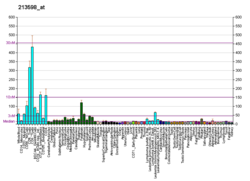Kinesin-like protein KIF2A is a protein that in humans is encoded by the KIF2A gene. [5] [6] In mice, KIF2A is essential for proper neurogenesis and deficiency of KIF2A in mature neurons results in the loss of those neurons. [7]
Contents
Kinesins, such as KIF2, are microtubule-associated motor proteins. For background information on kinesins, see MIM 148760.[supplied by OMIM] [6]








